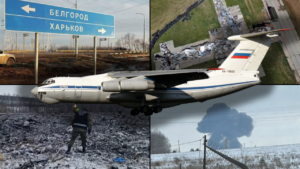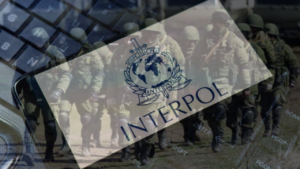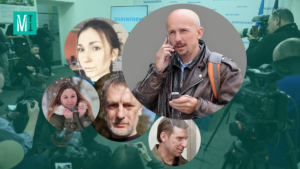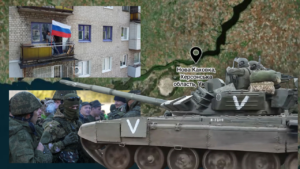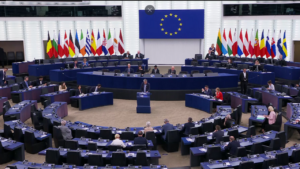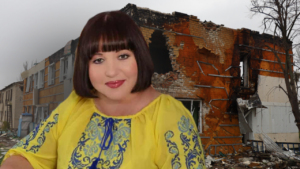VANISHED UNDER OCCUPATION: Where Russia Is Holding Ukrainian Captives
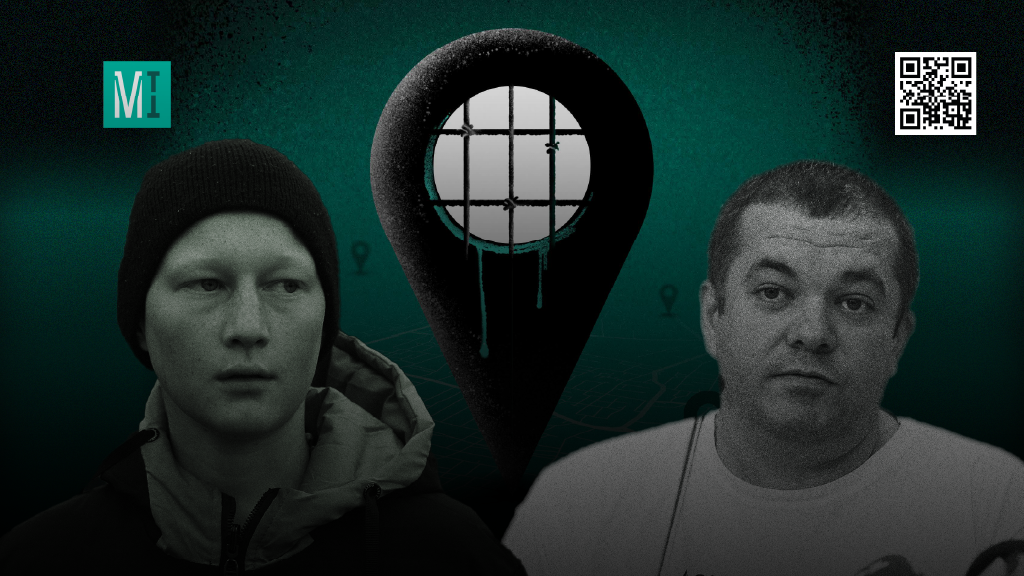
A full year has elapsed since the full-scale Russian invasion of Ukraine began. The Ukrainian Armed Forces successfully repelled the invaders, recapturing and fully de-occupying Kyiv, Chernihiv, and Sumy regions, and partially reclaiming Mykolayiv, Kharkiv, Kherson, Donetsk, Zaporizhia, and Luhansk regions.
Throughout the year, the MIHR has diligently recorded the war crimes and other atrocities perpetrated by the Russian army in Ukraine, which are both shocking in their scale and brutality. Among the most frequent offenses are the arbitrary detention and hostage-taking of civilians who are often held together with prisoners of war. The Russian military is committing acts of terror, such as abducting, torturing, and killing innocent men, women, and children. The MIHR documented the first cases of forcible disappearances of civilians in February 2022, marking a disturbing escalation in the brutality of this phase of the conflict.
WHY DETENTION OF CIVILIANS IS A CRIME
Under international law, the arbitrary detention and taking of civilians hostage during armed conflict are strictly prohibited. The forcible displacement of the population by the occupying force, such as Russia in this case, constitutes a war crime at the very least. However, given the widespread practice of deporting Ukrainians to specially prepared detention facilities, it may also amount to a crime against humanity, which is a more severe international crime. In addition, the illegal detention, mistreatment, and poor conditions of confinement of displaced civilians violate multiple international conventions. It is important to note that the prohibition of torture is a peremptory norm of international law that must be upheld by all states, even during times of international armed conflict.
Russia has been persistently breaching international law since 2014. Throughout the year of the full-scale war, the MIHR has extensively documented and analyzed the situation in the occupied territories, revealing several recurring patterns in the behavior of the occupiers. These repetitive elements of criminal conduct suggest a systemic nature to their offenses.
Since 2014, Russia has exerted effective control over specific districts in Donetsk and Luhansk regions (the uncontrolled portions of the Donetsk and Luhansk Oblasts are commonly abbreviated as “ORDLO” from Ukrainian) and the Autonomous Republic of Crimea. As a result, the Russian Federation is held responsible for any offenses committed by representatives of the quasi-authorities in ORDLO, as well as the Russian military and their affiliates in Ukrainian territory since 2014.
STATISTICS
As of early April 2023, the MIHR was able to identify 948 civilian hostages being held in the Russian Federation and occupied territories. However, it is believed that the actual number of released civilians who were once hostages and those who are still being held could be at least 5-7 times higher. Unfortunately, Russia has not been forthcoming with information about the detained civilians, withholding details from their families, Ukraine, and international organizations. The majority of these civilian hostages were abducted from Kherson, Kharkiv, Donetsk, Luhansk, and Kyiv regions.

The MIHR has identified five significant stages in the lives of civilian hostages based on documented testimonies. These stages are as follows: (I) detention, which includes identifying who was detained, how they were detained, and where they were held; (II) the conditions of their detention; (III) the charges against them and their treatment while in captivity; (IV) their place of confinement; and (V) their eventual release.
І. Who gets detained by the Russian military, how and where?
Civilians are being detained arbitrarily without any documentation, and the Russian military and their affiliates in the occupied territories often fail to provide any explanation for the detention. Shockingly, individuals are sometimes abducted for no apparent reason other than having a photo on their phone that the occupying forces find suspicious. Furthermore, there are no clear criteria for what constitutes such suspicion. The residents of southern Ukraine, as well as those living in Kyiv, Sumy, and Chernihiv regions, which were under occupation during the initial weeks of the full-scale aggression, were particularly vulnerable to arbitrary detentions by the Russian military. There have been instances where people were taken from their homes without any explanation whatsoever.
The occupiers have been also detaining individuals on separate lists, including activists, journalists, and former anti-terrorist operation participants who are no longer serving in the military.
Individuals are also being detained during the so-called “filtration” process. For instance, residents of Kherson region have only one evacuation option: passing through occupied Crimea, then through Russia, and finally reaching a third country. There are two routes leading from Kherson region to the peninsula, one through Chonhar and the other through Armyansk. However, the Russians have established filtration points along these routes and are detaining those who fail to pass the screening process.
Inga, the sister of Ihor Bondarenko, who was detained at the Armyansk checkpoint during the filtration process, recounts her brother’s experience:
“According to a witness who saw Ihor’s detention, he remembered my brother because he was the only person who was detained and subsequently prevented from boarding the bus. He said that all of the men were subjected to a lengthy inspection. They detained two individuals simultaneously, but released the younger man, allowing him to board the bus while Ihor was taken away.”
In addition to men, hostage-taking also affects vulnerable groups such as small children, teenagers, women, and the elderly.

A former civilian hostage from Donetsk region recollects being held captive merely because of her patriotic views towards Ukraine. Shockingly, among the detainees were children, the elderly, and even a child with a disability:
“The children did not understand anything. The youngest girl was six years old.”
“It was tough. People had nervous breakdowns, experienced hysterics, and cried due to the intense anxiety they felt. One person was 79 years old at the time, another was 78,” says a former hostage who saw it all.
Vitaliy Mukharsky, a teenager, was detained for taking pictures of broken Russian military equipment near his home. Despite being just 14 years old, he was held captive for ten days. Shockingly, the Russian military did not take his age into account and held him in a shower room alongside other detained civilians.
Tatiana, daughter of hostage Mykola Savchenko from Kherson region, recalls:
“He was taken captive not even from his own home, but from his neighbor’s house where he was playing chess. The Russian military broke into the house, blindfolded them, and took them away in the trunk of a vehicle. Father, who is 58 years old, was also taken on April 3, 2022, and has not returned to this day. They also took young people prior to that, as they have no age limit.”
Volodymyr Khropun, a Red Cross of Ukraine volunteer from Kyiv region, recounts his experience of being detained:
“Some of us were subjected to torture. I personally witnessed two stun guns being used on one young man. On March 23, 2022, a group of 14 people, including myself, were taken from Dymer. Along the way, one more woman was added to our group. We spent the first night at the Hostomel airport before being transported to Belarus in two Ural trucks. There were 35-37 individuals in each truck, with only a few soldiers among them. Approximately 90% of the detainees were civilians. We were coerced into signing documents while being blindfolded, without any explanation of the contents. We were treated like commodities, abducted and transported to another country where they subjected us to interrogations without any semblance of legal protection.”
It is important to note that civilian hostages are frequently detained alongside prisoners of war.
ІІ. Conditions of detention
The conditions of detention of civilian hostages are inadequate. They are frequently detained alongside prisoners of war, in unsanitary environments that lack sufficient provisions of food, drinking water, and medical care.
A woman from Donetsk region recounted to the MIHR the conditions in which her mother, a disabled civilian, was held in Pryazovsk penal colony No. 107, and prior to that in Olenivka, which is where Russia detains Ukrainian prisoners of war and civilian hostages:
“My mother is a group 3 disabled person, with a brain cyst that causes epileptic seizures. She requires daily medication, but they refused to accept a package for her.”
The woman is aware that her mother was previously admitted to a psychiatric hospital in Donetsk, where she was administered injections and coerced into taking certain medications. Following her release from the hospital, she was transferred back to the detention facility. However, when her mother began experiencing seizures once again, she was transferred to a rehabilitation center in Donetsk, where she stayed for a month before being returned to the Olenivka facility once more.
Since March 2022, both civilians and military personnel have been detained in Olenivka. Irrespective of their status, all detainees are subjected to the admission process, which is one of the most horrendous procedures that occur in the first few hours after an individual is brought to the detention center. Upon arriving, the detainees are subjected to mockery, physical violence, verbal abuse, and are herded like a flock of sheep towards the prison building.
“I was forced into a squat, where you have to sit down in a crouched position with your hands behind your neck and without lifting your heels. We were expected to stay in this position for hours on end. Many people were unable to withstand the discomfort and started moving or standing up. The guards responded with violence, using truncheons or kicking the detainees. The worst part was that civilians and soldiers were detained together, with no differentiation made between the two,” volunteer and former hostage Ihor Talalay recollects the inhumane treatment.
Testimonies from detained civilians shed light on the dreadful conditions present in the prisons where Ukrainian hostages are transferred. For instance, some former prisoners refer to the Kursk pre-trial detention center as “hell on earth.” One woman shares her experience of the admission process at this facility:
“They immediately had me sit on a chair and gave me a crew cut. I was then taken to a bathhouse where I was doused with cold water. Following that, I was led to a cell with four other ladies: three border guards and one who had previously worked at the Chornobyl nuclear power plant. One of the girls attempted to hang herself using a sheet, and as a result, the guards confiscated all of our sheets and towels. I am unsure of what happened to her afterward as I was eventually released and she was left behind. She, like myself, was not a soldier and had identified herself as a correspondent.”
ІІІ. Accusations and treatment of hostages
The Russian military and representatives of quasi-authorities in the occupied territories of Ukraine frequently level accusations against civilian hostages, alleging that they have committed “acts of international terrorism,” “high treason,” or have obstructed the “special military operation.” In doing so, they often reference the “L/DPR criminal codes” or maintain that Russian law is applicable. However, the majority of hostages are detained without formal charges, likely serving as bargaining chips for future exchanges.
Nearly all detainees are subjected to various forms of abuse, ranging from psychological manipulation to outright physical violence. Tragically, there are numerous instances of torture of hostages. Furthermore, intimidation tactics are routinely employed against the civilian population. One such tactic involves mock executions, which are distressingly commonplace.
During his detainment, Vitaliy Mukharsky, a 14-year-old resident of Kherson region, was threatened with the possibility of a lengthy imprisonment term. The captors asserted that criminal liability in Russia commences at the age of 14.
A former hostage from Donetsk region, who prefers to remain anonymous for safety reasons, recounts her detention experience in the following manner:
“I was accused of being a Ukrainian patriot. They threatened to assault me and imprison me in a basement alongside hardcore criminals. Though they didn’t resort to physical violence against me, my lady friend was physically assaulted during the interrogation. She was struck in the face.”

The wife of Bohdan Tislak, a civilian hostage from Donetsk region, says that he was initially charged with a criminal offense by the occupiers. Subsequently, his status was altered to that of a prisoner of war:
“A criminal case was opened against him by the occupiers, accusing him of being a traitor to the “DPR” due to his previous involvement in the anti-terrorist operation. Eventually, he was recognized as a prisoner of war like everyone else who fought in the ATO/JFO since 2014. However, this was in contravention of international legal norms or the Geneva Conventions. This is because he was not a combatant at the time of his abduction, did not take up arms, had already been demobilized, and more than a year had passed since his service. As a result, her husband was simply abducted and has been forcibly detained for over eight months now.”

A civilian hostage from Zaporizhia region, who wishes to remain anonymous, shared his experience after being exchanged for a Russian:
“Upon our arrival at Olenivka, we were reclassified as prisoners of war instead of civilians. We were housed in barracks and subjected to constant physical abuse, including beatings to the face and weapons being discharged near our heads. In Tokmak, we were blindfolded with hats over our eyes and deliberately pushed to hit our heads on iron pillars, before being beaten with a baton on our legs and backs. They also subjected us to beatings in Melitopol. First one Chechen beat me with a stick, another one with his fists, and yet another one kicked me, while other prisoners were also electrocuted. Everyone in Kursk was also beaten, and I was placed in a cell at 6 a.m. the following day after being mistreated, forced to crawl until my elbows bled, and my head smashed. They beat us for fun using tasers and truncheons.”
Mykola Savchuk, a freed hostage from Kyiv region, says:
“They hit the kneecaps skillfully, without leaving marks. One old man was beaten badly. They took him for interrogation, and he had a hearing aid with a dead battery. They thought he was pretending to be deaf. They beat him so badly that he could not stand up.”

Valentyn Hryshchenko from Kyiv region also testified to mistreatment during his detention:
“They grabbed me on the street on March 23, 2022, while I was volunteering and distributing humanitarian aid to civilians. After being blindfolded and having my hands tied, I was transported to the foundry. The beatings began after a day of confinement, with one person hitting me while the other restrained me, and a third one standing nearby. The captors did not identify themselves with call signs and only declared that they were the NKVD and had the authority to determine who lives and who dies.”

Viktor Prokhun from Kyiv region testified about an incident where he was subjected to a mock execution. During a search, Ukrainian books on patriotic topics were found in his possession:
“When they found the books, one of the soldiers exclaimed: ‘You are exactly what we’re looking for. They pay us a million for a real Banderite.’ They then brought me to a well for an execution. They forced me to my knees and started firing rounds over my head.”
ІV. Place of detention
Civilian hostages are being held in the occupied territories of Ukraine and the Russian Federation, and even deep inside Russia, with frequent movements occurring. Additionally, the MIHR has documented cases of people being held in Belarus.

Places of detention of civilian hostages in the territory of Ukraine liberated by the Armed Forces of Ukraine

Places of detention of civilian hostages in the occupied territories of Ukraine as of March 14, 2023
The MIHR has developed an interactive map that displays the locations where the Russian Federation detained or is currently holding civilian hostages and prisoners of war. The map undergoes regular updates and additions after thorough verification by the MIHR.
V. Release

The principles that Russia follows when releasing civilian hostages remain unclear, as some are exchanged while wearing military uniforms as if they were Ukrainian prisoners of war for Russian prisoners of war, while others are released with no apparent justification, just as they were detained. Additionally, some civilians are simply exchanged together with the military. Moreover, a significant number of released civilians in occupied territories are compelled to leave their home settlements on the pretext that they pose a threat to the Russian order in these areas.





